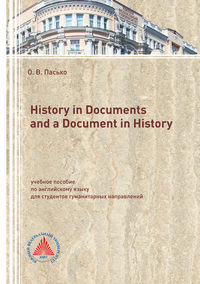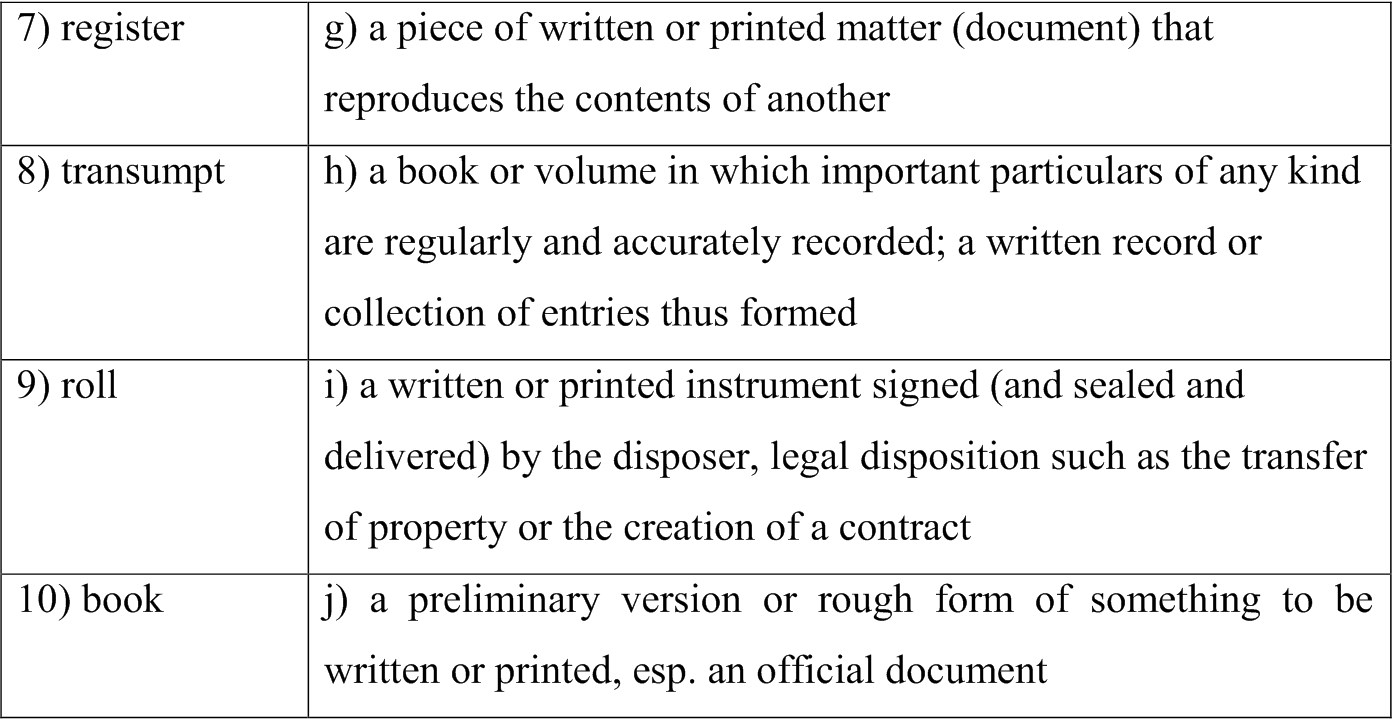
History in Documents and a Document in History
1) What documents are original?
2) What are drafts?
3) What are copies?
4) How could people create several originals?
5) How did the method of chirography work?
6) What was the method of chirography used for?
7) How can a document get the force of the original?
8) What led to the certification of forged documents?
9) Under what circumstances forged documents could receive validation?
10) What were registers used for?
11) What are the examples of registers?
12) What did the formula books contain?
2. Match the words to their definitions:


3. Fill in the correct word from the list below. Then, use the collocations to make your own sentences:
incoming, formula, forged, proof, validation, dignitaries, keeping, imperial
1) …………………. register
2) …………………. chancery
3) …………………… records
4) to receive …………………
5) ………………… documents
6) …………………. books
7) …………………. of authenticity
8) secular …………………….
Text 2. Classification of documents
Read the text and do the tasks after it.
The documents of the Middle Ages are usually classified under two groups: public documents, which are those of emperors, kings, and popes, and private documents, which comprise all others. Another way of classifying documents is according to whether they are evidentiary or dispositive. The former merely record a valid legal act already executed orally, while the actual issuing of the latter forms in itself the legal act. This distinction, found among Roman documents from the 3rd century A.D. onward, gradually ceased to exist after the early Middle Ages.
After the collapse of the Carolingian empire in the 9th century, private documents lost much of their function and were replaced by simple memorandums about legal acts and the witnesses to them. It was not until the late 11th and early 12th centuries that sealed charters of high secular or ecclesiastical dignitaries were again gradually considered as dispositive. Papal documents can be classified mainly as either letters or privileges, and royal documents can be classified as diplomas or mandates. Privileges and diplomas give evidence of legal transactions designed to be of long duration or even of permanent effect, while mandates and many papal letters contain commands.
1. Answer the questions to the text:
1) Give definitions to public documents and private documents.
2) What`s the difference between evidentiary and dispositive documents?
3) What documents replaced private documents?
4) When and why did private document lose their functions?
5) What was the classification of papal and royal documents?
6) What is the difference between papal and royal documents?
2. Find all the types of documents mentioned in the text and give definitions to them in your own words.
Text 3. Materials used for the early documents
Read the text and do the tasks after it.
Documents were written on a variety of material. In antiquity there were documents of stone, metal, wax, papyrus, and, occasionally, of parchment, but only papyrus and parchment (and, very occasionally, wax) were used during the Middle Ages. From the 12th to the 13th centuries, paper was also available.
Papyrus, made from the stem of the papyrus plant, was produced mainly in Egypt. The Merovingian kings wrote their documents on papyrus until the second half of the 7th century, and the popes did so until far into the 11th century. North of the Alps papyrus had finally disappeared by the 8th century, when it was replaced by parchment.
Parchment was made from animal hides and was thus easier to obtain. In southern Europe it was made mainly from sheep and goat hides; the insides of the skin were thoroughly smoothed and calcined, while the hairy sides were left rougher. In central and northern Europe, parchment was usually made from calves’ skins, and both sides of the hides were thoroughly smoothed and calcined.
Paper came originally from China. During the 8th century AD, it spread to the Arab world and from thence to Byzantium, where it was manufactured from linen and was used from the 11th to the 13th centuries for imperial documents. After that time ordinary paper was used in the Byzantine Empire. In the West the use of paper, most common at first in southern Italy and Spain, had begun to spread by the beginning of the 12th century. Germany and southern France began to import paper from Spain and Italy in the 13th century, and soon afterward it had reached England by way of Bordeaux. But paper did not altogether replace parchment, which long remained in use, especially for solemn documents.
Конец ознакомительного фрагмента.
Текст предоставлен ООО «ЛитРес».
Прочитайте эту книгу целиком, купив полную легальную версию на ЛитРес.
Безопасно оплатить книгу можно банковской картой Visa, MasterCard, Maestro, со счета мобильного телефона, с платежного терминала, в салоне МТС или Связной, через PayPal, WebMoney, Яндекс.Деньги, QIWI Кошелек, бонусными картами или другим удобным Вам способом.
Вы ознакомились с фрагментом книги.
Для бесплатного чтения открыта только часть текста.
Приобретайте полный текст книги у нашего партнера:
Полная версия книги
